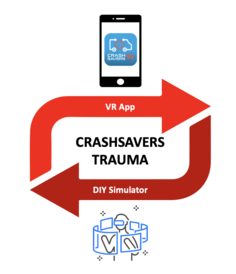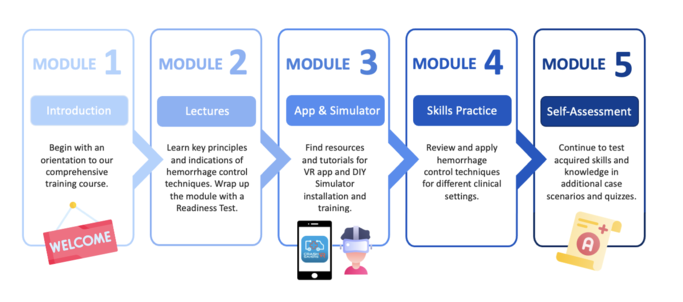
CrashSavers Trauma is focused on teaching firefighter first responders in Guatemala how to stop bleeding in injured individuals and prevent mortality from hemorrhagic shock. Low- and middle-income countries lack an organized prehospital infrastructure. This, coupled with the absence of formal medical training for prehospital providers, creates suboptimal conditions for providers and patients. Improvement in provider competence and thus, patient safety, are at a standstill until formalized training in hemorrhage control techniques is provided.
We have created a comprehensive training course to teach clinical decision-making and technical skills critical to stopping life-threatening bleeding that can occur anytime to anyone. Learners will learn different approaches to control bleeding, including applying pressure, packing, tourniquet, and balloon compression. The course consists of 2 primary components: a virtual reality (VR) smartphone application and a do-it-yourself (DIY) simulator. Utilize the syllabus along the page's right side to navigate the different modules.

Objectives
- Describe and differentiate four hemorrhage control techniques
- Explore and apply hemorrhage control techniques in various contextual settings
- Simulate different hemorrhage control techniques through a virtual reality platform and a physical model
- Enhance clinical decision-making and technical skills to manage life-threatening bleeding
Who can participate
Learners are expected to have undergone basic first responder skills training before starting this course. This course is designed for prehospital personnel, though anyone is welcome to participate.
Syllabus[edit | edit source]
Introduction & Our Purpose[edit | edit source]
Basics[edit | edit source]
Tourniquet, Pressure and Packing, and Foley
Tourniquet[edit | edit source]
Pressure and Packing[edit | edit source]
Foley[edit | edit source]
App & Simulator[edit | edit source]
Skills Practice[edit | edit source]
[edit | edit source]

Learners will begin with an orientation to the course in Module 1, “Introduction.” They will then explore Module 2 “Lectures” to learn fundamental principles and indications of hemorrhage control techniques. In this module, we recommend that learners study the educational content before completing the readiness test.
Our module will guide learners through installing a smartphone application, CrashSavers VR, that contains content review and case scenarios. Learners can experience case scenarios via 2D or Virtual Reality (VR). Case scenarios will be scored based on clinical decisions made by learners to stop bleeding in simulated patients. Scoring is based on the quality and speed to answer selection. Correct answers will prompt learners to utilize the DIY Simulator to continue testing knowledge in a real, non-digital environment. Incorrect answers will end* the case scenario, and learners will be provided with pertinent educational material to review.
Resources for VR app and DIY Simulator installation and tutorials are found in Module 3 “VR App and Simulator”. Simulators connect to the CrashSavers VR app via Bluetooth. Learners can review and apply hemorrhage control techniques for different clinical settings in Module 4 “Skills Practice”. Finally, Module 5 “Self-Assessment” provides additional case scenarios and quizzes for learners to continue practicing and testing themselves on their acquired skills and knowledge.
Learners can use the syllabus on the right side of the webpage to navigate different parts of the course.
Additional Resources[edit | edit source]
For learners who complete our CrashSavers Trauma course and wish to continue practicing their acquired skills, they can find additional resources for study: